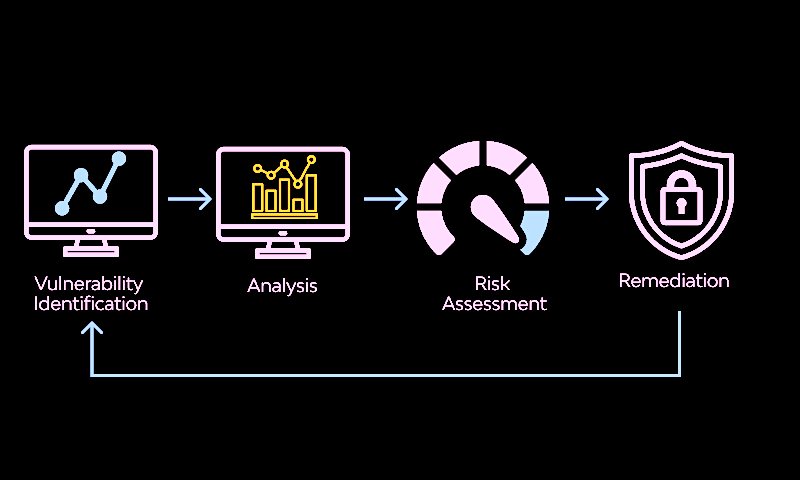
A Vulnerability Assessment Procedure typically involves systematically identifying, evaluating, and addressing security vulnerabilities in an organization’s systems and infrastructure. Below is a step-by-step guide to performing a Vulnerability Assessment:
Step 1: Preparation
- Define Scope:
- Determine the systems, networks, or applications that will be assessed. This includes servers, databases, workstations, and mobile devices.
- Decide whether the assessment will cover internal, external, or both types of networks.
- Establish Objectives:
- Define the goals of the assessment, such as discovering vulnerabilities, evaluating existing security measures, and minimizing risks.
- Identify Stakeholders:
- Involve relevant personnel such as IT staff, network administrators, and security professionals.
- Get Authorization:
- Obtain the necessary permissions for testing, especially for live systems or networks, to avoid legal issues.
Step 2: Information Gathering
- Network Mapping:
- Identify the architecture of the network. Understand how devices are connected and their dependencies.
- Asset Inventory:
- Create a list of all hardware, software, and systems in use, ensuring no critical asset is overlooked.
- Collect Data:
- Collect relevant information such as IP addresses, operating system versions, and application types. Tools like Nmap and Netcat can be used to scan the network.
- Review Documentation:
- Review previous vulnerability reports, system configurations, and security policies to gather contextual information.
Step 3: Vulnerability Scanning
- Select Vulnerability Scanning Tools:
- Use automated tools like Nessus, OpenVAS, Qualys, or Nexpose to scan for known vulnerabilities in the systems.
- Perform Vulnerability Scan:
- Run scans on the identified assets, both on the network and for individual hosts.
- Consider scanning for different categories of vulnerabilities (e.g., software bugs, configuration weaknesses, missing patches, etc.).
- Review False Positives:
- Manually verify vulnerabilities that the scanner identifies, as they may not always be accurate.
Step 4: Risk Analysis and Prioritization
- Assess the Risk Level:
- Evaluate the severity of each identified vulnerability based on factors like exploitability, impact, and the criticality of the affected system.
- Assign Risk Scores:
- Use risk scoring systems like CVSS (Common Vulnerability Scoring System) to assign a numerical value to each vulnerability.
- Prioritize Vulnerabilities:
- Based on the risk scores, prioritize the vulnerabilities that pose the greatest threat to the organization’s assets and operations.
- Consider factors like the exploitability of the vulnerability, data sensitivity, and impact on business continuity.
Step 5: Remediation Planning
- Develop a Remediation Plan:
- Create a list of steps required to fix or mitigate each vulnerability. This might include patching software, reconfiguring firewalls, or updating security protocols.
- Allocate Resources:
- Assign personnel and resources to address vulnerabilities based on their priority.
- Set Timelines:
- Define realistic deadlines for remediation based on the severity of vulnerabilities and available resources.
Step 6: Implement Remediation
- Patch and Update Systems:
- Apply patches and updates to software, hardware, and systems to address vulnerabilities.
- Reconfigure Security Settings:
- Modify configurations to improve security, such as disabling unused services, applying stricter access controls, or implementing encryption.
- Install Additional Security Controls:
- Where necessary, deploy additional security measures like firewalls, intrusion detection/prevention systems, and multi-factor authentication.
Step 7: Verification and Reassessment
- Test Remediations:
- After remediation, perform another round of vulnerability scans to verify that the vulnerabilities have been effectively addressed.
- Conduct Penetration Testing (Optional):
- Perform manual or automated penetration testing to check if the vulnerabilities can still be exploited.
- Revalidate Risk Scores:
- Re-assess the remaining vulnerabilities and update their risk scores after remediation.
Step 8: Reporting
- Document Findings:
- Provide a detailed report including the vulnerabilities found, their severity, and steps taken to mitigate them.
- Provide Recommendations:
- Offer suggestions for further improvement of security policies and procedures, including ongoing monitoring and security training.
- Executive Summary:
- Present a high-level summary for non-technical stakeholders, outlining key vulnerabilities, their impact, and the measures taken.
Step 9: Continuous Monitoring
- Implement Continuous Monitoring:
- Set up ongoing monitoring to track new vulnerabilities, system changes, and patch updates.
- Schedule Regular Assessments:
- Perform regular vulnerability assessments (quarterly, bi-annually) to maintain a proactive security posture.
- Update Security Controls:
- Continuously improve security controls based on new findings, evolving threats, and industry best practices.
Conclusion:
A Vulnerability Assessment is an essential part of maintaining an organization’s security posture. By following this procedure, you can identify and mitigate vulnerabilities before they are exploited by attackers, ensuring the protection of critical assets.